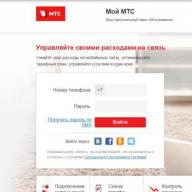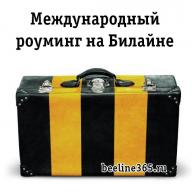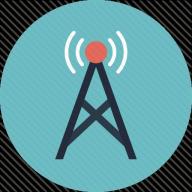Usually, the very concept of "Coverage Area" does not raise questions from Beeline subscribers or those who intend to become them or is an abstract combination of words that does not mean anything at all. At least until problems arise. However, it is worth noting that in order to avoid difficulties with communication, it is just worth finding out what a coverage area is and how its absence can be fraught with a mobile operator's client. This can be especially true for those who are going on a trip or a business trip and prefer to know what will await him in terms of communication along the way, or those who live in the outback and want to be sure that he will always have the opportunity to make a call or send sms.
The coverage area is actually the area where the Beeline connection works, or, as people say, “catches”. Usually it depends on the frequency of the location of the telecom operator's towers and the range of frequencies that are tuned to it. If you take a close look at the map of coverage areas https://moskva.beeline.ru/customers/beeline-on-map/ (link on the example of Moscow, you can also set your region there), you can note that almost the entire country is covered with towers ... But for what reason, then situations arise that in one place the network is simply perfect, and in another it is simply absent and nowhere except the rescue service cannot be reached.
Beeline coverage area on the map
In fact, the quality depends not only on the operator, but also on a number of objective factors that he cannot always influence:
- Low signal strength from the base station. It can also be affected by the fact that the antennas are located incorrectly;
- Uneven location of stations. This is not influenced by the whim of the operator, but the geography of the area, the relief, the features of the buildingif it is a settlement. The consequence of this may be an incomplete coverage of the territory;
- The quality indicators of communication are directly related to the building density of a particular area, the layout and thickness of the walls of the room where the subscriber is located;
- Natural and climatic conditions can directly affect the quality of communication. Precipitation degrades the capacity of communication channels.
Where and what technologies prevail
It is not a secret for anyone that in large cities the signal is usually the most powerful and there are never any problems with communication, since the stations here are located mostly evenly and often enough to cover the entire territory. In the provinces this is not always the case here. the cleanest signal prevails in regional and district centers, but the hinterland may be completely unable to communicate with the outside world through cellular communication.
3G and 4G technologies
If you look closely at the map, you can see that these types of Internet are not present throughout the country. The 3G signal is brightest in the central territory of Russia, and often regardless of the size of the settlement or the value of the route along which the traveler passes. East and North cannot boast of perfect broadcasting and reception of this technology.
4G technology is still being introduced in the vast expanses of Russia and base stations are so far equipped with it selectively, which affects its availability and quality. Presently 4G perfectly catches in Moscow, St. Petersburg and their regions... The big cities of the center also boast that this technology has reached them.
But as for the rest of the territories, here the technology is available only for regional centers where the LTE base is installed. While the service is available for 11 regions of the country, but Beeline is building up its power and promoting 4G, covering more and more new territories.
What says Roskomnadzor about the quality of Beeline communication
The Federal Service, which is called upon to oversee the communications sector, regularly conducts various checks in order to find out who and how does their job by providing the appropriate services. This is done solely so that each operator can see their flaws and strive for perfection.
Measurements were made selectively, using a mobile complex specially designed for the purpose of conducting inspections. Voice connections, SMS messages, Internet were checked. The parameters were different. For voice, these are failures, cuts, intelligibility and the proportion of unintelligible connections. Messages - by the time taken for delivery and the proportion of undelivered SMS, Internet - by speed, the proportion of unsuccessful connections, unsuccessful sessions and the duration of successful sessions The results were as follows:
- Beeline took 4th place in voice connections;
- By SMS - 1;
- Data transfer - 2.
The check showed that there is something to strive for, and Beeline is striving.

In general, when going on a trip, going to change your place of residence or going on a trip related to work or business, you need to check the coverage map to be sure that you will be constantly in touch or take measures in advance if the area where you go, the link does not extend. We can recommend the Roskomnadzor website. There is a map of the largest tracks and their coverage.
Of all operators in Russia, Beeline is noticeably inferior in coverage area. But unlike other operators, Beeline's 3G and 4G signal can be found in places where Megafon and MTS are not available.
This year, work was continuously carried out to expand the coverage of 4G networks in the Caucasus, the southern regions of the map of Russia and in cities located near the Volga River.
As of May 2014, LTE 4G network is available in 65 regions. Of these, Beeline accounts for 11 regions.
For the city of Moscow and Moscow region, an interactive map of the coverage of the 2G, 3G, 4G network is located on beeline website. If you need a different city, just change the Moscow region above to your region. Borders of tariff zones in Moscow and the region, WiFi points Beeline, network coverage map in the Moscow metro, you can see
Beeline base station network
The coverage area of \u200b\u200bany mobile corporation is provided by a complex of base station networks. The Beeline company works exclusively with modern equipment - these are the latest generation Flexi stations of Nokia Siemens Networks. These stations are designed to make a smooth transition from GSM 1800 networks to the more modern LTE standard.
Previously, signal amplifiers were used to improve the signal and increase the coverage area. Today, the Beeline uses updated base stations, the radio module in such stations is located close to the antenna and transmits the maximum power.
In the southern region of the country, the number of base stations operating on the HSPA + technology is growing, 60% of the stations are connected to high-speed channels, due to which a data transfer rate of 21 Mbit / s is achieved.
Coverage area 3G and 4G Beeline
The most remote region on the map of Russia, where 3G and 4G Beeline network is available, is the Yuzhno-Sakhalin region.
3G coverage map of Beeline in Russia
For most small towns and cities, the mobile network is the only access to the Internet, so its spread is a real revolutionary breakthrough in the field of mobile communications.
The maximum available speed in Beeline's LTE 4G networks is 60 Mbps, for 3G - 14.7 Mbps, the average LTE user speed is 15-20 Mbps.
The Internet access service, which is included in any tariff plan, is available to every subscriber, postpaid or prepaid payment system. To access the network, you need a USB modem or a smartphone that supports the WCDMA / UMTS format.
The small 4G coverage area is explained by the fact that Beeline started installing base stations a little later than its competitors - in May 2013. While MTS has been testing a new type of LTE network since 2011.
Despite this, today in Beeline there is an increase in the use of LTE 4G, the number of subscribers has increased more than 5 times throughout Russia. At the same time, the volume of consumed traffic in the network also became 5 times more.
You can view a more detailed map of the Beeline coverage area for your region on the beeline official website page ... In the same place, you can see Beeline WiFi hotspots and a Beeline map abroad.
Territory 3 ji, 4g, lte internet connections. Beeline's map and signal coverage in Russia, in the regions: Caucasus, Voronezh, Sverdlovsk, Nizhny Novgorod, Stavropol Territory. View the map and coverage area, coverage area of \u200b\u200bthe cellular network beeline 3g in the Russian Federation.
75 users found this page helpful.
Beeline is one of the four largest mobile operator companies in the Russian Federation. It provides good communication in large cities, villages and villages of the state. But how does it work in practice?
For this, the operator uses special towers that spread the network using antennas to the surrounding areas. It follows from this that the quality of communication depends to a large extent on the degree of remoteness of the nearest tower with the gadget. The larger the settlement, the more distribution towers there are.
Important: the distance from the nearest tower is the main, but not the only factor that determines the level of the network. Its quality is also affected by the direction of the antennas, building features, or even weather conditions.
3G coverage area
Communication can also be characterized by its quality. At the moment, there are 3 types of it: 2G, 3G and 4G. The former provides the minimum number of features, but is relatively easy to distribute, while the latter, on the contrary, can offer the client many functions and the highest data transfer rate, but requires more resources for distribution. With the development of technologies from 2G, modern operators have become increasingly distant, preferring to invest in the development of 3G and 4G.
Beeline distributes 3G mainly within Central Russia. Then there is a gradation of the strength of communication to the east by a narrowing strip running along the southern border. In the north, the network is distributed only in the vicinity of large cities such as Norilsk, Salekhard, Novy Urengoy. Also, a considerable number of towers are located on the Kamchatka Peninsula.
Important: the exact boundaries of the territories of the distribution of the network can be found on special interactive maps that highlight the distribution of the company's network.
According to Beeline statistics, the 3G Internet coverage in the Russian Federation is about 40%, and its predecessor 2G is slightly more than half.
By regions of Russia
You can call anywhere with a Beeline SIM card from almost any locality in the country, however, you will not be able to access the Internet with a sufficient data transfer speed everywhere. The company covers all constituent entities of Russia, but you need to find out about the quality of communication in a particular territory on the official website.
4G coverage area
The coverage area of \u200b\u200b4G is one and a half to two times less than that of 3G. It spreads in about the same pattern - excellent in the central part of the state, pointwise in the north and a strip narrowing to the east in the south. The largest and most technologically advanced cities and villages are now given priority.
Important: 3G is also available in all 4G territories, but far from everywhere where there is a second, the first is distributed.
According to Beeline statistics, the 4G Internet coverage area in the Russian Federation amounted to ~ 25% of the territory.
By regions of Russia
The strongest percentage of the 4G network is in the Moscow region, and less - within the Nenets Autonomous Okrug. Information about the rest of the subjects can be found on the official website.
Moscow and Moscow region
Moscow and the region have a record number of Beeline subscribers - in the fall of 2017 there were 37 million of them! Therefore, in this region, the maximum data transfer rate, technological options and functions are available. In addition to the usual 4G, 4G + is also available here - an improved version of the first.
Beeline operator network coverage map
Interactive map
As we can see, good communication quality is mainly inherent in large regions, such as:
- Moscow and Moscow region;
- St. Petersburg and the Leningrad region;
- And other large regions of central Russia - Tula, Ryazan, Tver, etc.
Video tutorial: how to use the interactive map
Card from the official company Beeline
The official map with coverage areas and salons of cellular communication from the operator beeline - map.
Screenshot:

Statistics of increasing the coverage area of \u200b\u200bBeeline 2G, 3G, 4G (table is needed)
Summarizing
How developed is the telephone coverage
The territories not covered by the Beeline network, in the absolute majority, are uninhabited wild expanses of taiga, steppes, forests, as well as mountain ranges, so practically no subscriber will remain without communication, if he lives in at least some settlement, is not cut off from society ...
Introduction
One of the first questions that arises when you are connected to the mobile Internet is the question of the location of the base station of the operator of your choice in order to point your antenna in its direction. It is advisable to find out the exact coordinates of the tower and the relief to it in order to understand whether it makes sense to use the tower to receive a signal. Services and various android applications do not give the exact coordinates of the BS, tk. based on measurements and their mathematical processing. In this case, the error can reach several kilometers.
Often, the tower coordinates can be established by studying operator coverage maps, terrain, Google and Yandex maps, as well as the opportunities they provide to view photographs and panoramas of the area under study. I must say that BS on the map can not always be found. There may be many reasons for this - the maps are outdated, the BS is located on the roof of the building and is simply not visible on the map, the tower is small, etc.
BS parameters are unknown. Kostroma region
Given: coordinates 57.564243, 41.08345, Kuzminka village in the Kostroma region. The task is to determine the exact coordinates of the BS to which you can connect to receive 3G-signal.
We will consider the search for BS in steps.
Step 1. Analysis of coverage maps.
We will use a well-known servicehttps://yota-faq.ru/yota-zone-map/ , which shows the coverage areas of four operators, except for Beeline. I note here that the Beeline coverage presented on their off-site is almost impossible to use - as a rule, a continuous coverage is shown there that does not take into account the terrain.
The most interesting from the point of view of connection are the coverage areas of Megafon and MTS. You can see for yourself by opening the service, pasting coordinates into the search bar and switching operators.
Megaphone coverage area:
MTS coverage area:
From the analysis of the Megafon coverage area, we see that 3G BSs are most likely located in the directions of Krasnoe, Sukhonogovo, Lapino (on this scale, Lapino's map is not visible, it is southwest, approximately where the P-600 mark is).
The coverage area of \u200b\u200bMTS is more interesting. Here we also consider the direction to Sukhonogovo and Krasnoe. But Red is a more interesting option, because there is 4G coverage. The distance to Krasnoye is about 10 km, if MTS distributes 4G at a frequency of 1800 MHz, that is, there is every chance of establishing communication with one of the MTS BSs located in this settlement.
Step 2. Study of the terrain.
The relief up to Red is not easy, but quite penetrable. To assess the relief, we will use the service https://airlink.ubnt.com. If this is your first time on this site, then first you will need to go through a free registration procedure. Having opened the service, scroll the slider down to the end and enter the initial data in the lower right corner, as shown in the following figure.
I usually first enter the same coordinates in both windows, and then I begin to move the purple label to the points of interest to me, where the BS may presumably be. In this case, the relief, line of sight and the approximate size of the Fresnel zone are displayed in the upper right corner of the screen.
For our coordinates we have:
Checking the relief in other "suspicious" directions showed that the relief there is much worse. Thus, we decided on the direction and at the same time chose the operator - MTS.
Step 3. Clarification of our choice using the "Quality of Communication" service
The service opens at the following address https://geo.minsvyaz.ru. In the search line, we set the name of the village Kuzminka, switch the view from 4 windows to one-window mode, scale the map to a convenient size and get for the MTS operator:
We see that our choice is correct, because according to the measurement database of users of this service, Krasniy does indeed have good 4G coverage from MTS.
Let's zoom in on this map and see that the most likely location of the tower (or towers) is Sovetskaya and Okruzhnaya streets.
Step 4. Exploring the area using Google and Yandex maps.
These maps have a useful tool for studying the area - panoramas and photographs of the area. Google maps have much more panoramas of different areas than Yandex, so you often have to use Google when looking at panoramas. On the other hand, Yandex has more photos taken in different places, and besides, Yandex maps are usually more relevant for Russia. In this regard, you have to use both services. It uses Google maps and services.
So, we found out that we need to consider two streets in Krasny in search of BS. We launch Google maps, enter the approximate coordinates of st. Sovetskaya (or street name) and we get:
Street view is on here, the street we need is highlighted in blue on the map. You can get a panorama of the street by clicking the mouse anywhere on the blue line. Moving in this way along the street to the north, we find the first BS near the post office:
And finally, not far from the intersection of Sovetskaya and Okruzhnaya streets, a third tower is discovered, the highest one found:
We return to the map and find the shadow of this tower in the place where the photo points:
We mark this place on the map with the mouse and get the exact coordinates of the BS:
Let's summarize some of the results of our research. With the help of information obtained from the analysis of coverage areas, custom measurements of signal strength in the area of \u200b\u200binterest to us and study of the area from photographs and panoramas, we were able to find three base stations and their exact coordinates in a city that we have never been to. The question of which operator the found BS belongs to remains open, since the answer to it requires additional research. The easiest way is to drive along the route and measure the BS parameters using some android application that gives MNC, MCC and signal strength. Some of these applications are presented.
The BS parameters are known. Suburb of Penza
As you know, a number of android applications, as well as the HiLink modem interface and the MDMA program can give BS parameters, with the help of which known services and applications can give approximate BS coordinates, which makes it easier to find specific BS coordinates on maps. Reviews of some of these tools are given in the "" section of the Antex website.
Let's look at a specific example from the forum, an example is based on a topic. User coordinates
When buying a SIM, a client expects a signal to be available both in the city and beyond. The territorial coverage of the mobile Internet is provided by the range of the operator's network. Beeline is one of the largest providers in Russia and by the number of towers supporting 4G technology confidently shares the second place with MTS. Beeline coverage area and other secrets below in the article.

3G coverage area
3G - high speed mobile internet. It is included in the operator's package of services at basic rates. There is a connection within all settlements. 3G is available for smartphones and. Tariffication is charged according to the consumption of megabytes upon connection. The provider provides several packages with 3G within the # service. High-speed connection available for tablets and computers.
3G is also provided in archive tariffs. Depending on the service package, high-speed Internet traffic is 100 MB, 1 GB, 4 GB and 5 GB. The megabyte consumption is limited to the territory of the home network. The connection speed does not affect the MB consumption.
Geographically, the 3G network covers 80% of cities in Russia. High speed connection is available thanks to antennas. They are placed at the same distance from each other. The signal is transmitted within the communication range.
There are towers all over Russia. You can see the location of access points on the 3G coverage map from Beeline. All sources are marked with geolocation. 3 Gee is marked in yellow. Connection problems are observed only in villages remote from the central part of the country.
High speed internet 4G
Mobile technologies have advanced, and now many operators, in particular, Beeline, provide a better connection. Super fast internet is called 4G. The 4G coverage area from Beeline is shown dotted. Most of the towers are located in the central regions: Moscow and the Moscow region, St. Petersburg and the surrounding regions (Oryol, Tula, Ryazan, etc.).
Base stations LTE Beeline are installed only in large cities. The service is available in 11 regions of the country. The coverage of territories is increasing annually.
The difference between 3G and 4G is in the download speed. When connected to a 3 Gee tower, loading a website page takes 3-4 seconds, while 4 Gee does it instantly. Recently, the operator has been distributing the latest generation of 4G + mobile internet. It is only available in Moscow.
Network activity map
The operator's towers are arranged in layers. The provider has established 2G / 3G / 4G / 4G + networks by overlapping sources. The coverage radius of 1 antenna is 1.13 km2 at a source frequency of 2,600 MHz and 4, 52 km2 at 800 MHz. This means that the Beeline LTE coverage card provides a range 4 times longer than when using standard high-speed towers.
















